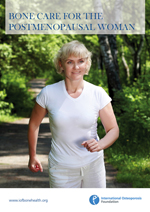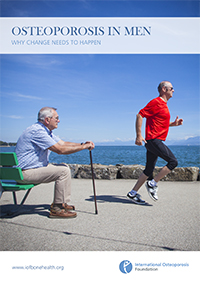Generally, osteoporosis and the fractures that it causes occur in women and men aged 50 years and over.
Some younger people develop osteoporosis on account of having specific medical conditions, or as a side effect of taking certain medicines.
During 2013 and 2014, the International Osteoporosis Foundation (IOF) has highlighted, through World Osteoporosis Day reports, that osteoporosis affects both women and men. The 2013 report was on the subject of osteoporosis in post-menopausal women and the 2014 report is concerned with osteoporosis in men.
 |
 |
The most important group of people who should be assessed for osteoporosis are women and men aged 50 years and over who have suffered a fracture (a broken bone) as a result of a minor fall or bump. Health professionals will often refer to such fractures as ‘fragility fractures’, a term which has exactly the same meaning as ‘fracture caused by osteoporosis’.
If you have suffered a fracture (a broken bone) as a result of a minor fall or bump, ask your doctor for an osteoporosis assessment.
People who have suffered a first fracture caused by osteoporosis are at significantly higher risk of suffering second and subsequent fractures, as compared to people who have not suffered fractures. Indeed, half of people who break their hip have suffered a previous fracture caused by osteoporosis.
So the first fracture should always serve as a signal to alert the person and their doctor that they are at risk of suffering more fractures in the future. The IOF devoted the 2012 World Osteoporosis Day report to the Capture the Fracture Campaign, which calls for all patients suffering fractures caused by osteoporosis to receive the care that they need to prevent future fractures.
The links below provide information on risk factors for osteoporosis and fractures in women and men, and a list of medicines which are known to have bone loss as a side effect.
Medicines which may lead to bone loss
Long-term use of corticosteroid drugs (e.g. prednisone) has been associated with loss of bone density. Accordingly, if you are taking these medicines your doctor is likely to discuss bone health with you and may offer treatments to prevent bone loss.
The following classes of medicines may also lead to bone loss. If you are taking one of these medicines ask your doctor whether you need an osteoporosis assessment.
- Androgen Deprivation Therapy (for treatment of prostate cancer in men)
- Aromatase inhibitors (for breast cancer and ovarian cancer in postmenopausal women)
Risk factors for osteoporosis and fractures in men
Common risk factors for osteoporosis and fractures in men include:
- A fracture (a broken bone) which resulted from a minor fall or bump
- A family history of osteoporosis and fractures (e.g. a parent who suffered a hip fracture)
- Crohns disease or celiac disease
- Vitamin D deficiency
- Rheumatoid arthritis
- Low sex hormone levels (i.e. testosterone)
- Excessive alcohol intake (i.e. more than two 120 ml glasses of wine per day)
- Smoking
- Being underweight
The National Osteoporosis Foundation in the United States provides a useful overview of risk factors.
Risk factors for osteoporosis and fractures in women
Common risk factors for osteoporosis and fractures in women include:
- A fracture (a broken bone) which resulted from a minor fall or bump
- A family history of osteoporosis and fractures (e.g. a parent who suffered a hip fracture)
- Crohns disease or celiac disease
- Vitamin D deficiency
- Rheumatoid arthritis
- Early menopause (i.e. before age 45 years)
- Excessive alcohol intake (i.e. more than two 120 ml glasses of wine per day)
- Smoking
- Being underweight
The National Osteoporosis Foundation in the United States provides a useful overview of risk factors.





 Print
Print